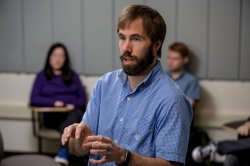Why All the Chatter About ChatGPT?
Professors say use of artificial intelligence in the classroom may reshape the way they teach
Posted in: Communication and Media, Homepage News, University

Professors at Montclair State University – and throughout the world – are working to figure out the best ways to approach the new wave of artificial intelligence (AI) that is reshaping the ways students learn about writing. The tool, ChatGPT, is able to compose college essays, marriage proposals, business letters, song lyrics, computer code and – as an introductory class on news reporting and writing would find out – news stories. All created in response to short prompts.
“It’s such a new technology and I’m still thinking it through in terms of how to handle it, how to introduce it, when to introduce it and what to teach them and what not to teach them,” says School of Communication and Media Associate Professor Tara George.
In a recent class, George decided to dive right in to better understand the chatter behind ChatGPT, inviting her students in her Introduction to Journalism course to use the bot to test how convincing it can be in writing a news story – in this case her Montclair students being featured on a recent NBC New York news segment, “ChatGPT: How students are using and learning from artificial intelligence.”
“We looked at it together just to see what it could do, and what the students noticed is that it does in seconds something that the students are building up to learning over the course of the semester,” George says.
Across campus, professors are wrestling with how to use artificial intelligence in their classrooms. There are concerns that ChatGPT threatens to normalize plagiarism – and in journalism, create fake news. Some professors are redesigning their assignments in response.

“There are times when I look at it and just think, ‘Oh my gosh, this whole thing makes me want to run off to the woods and forget about it altogether.’ But we can’t do that,” says Writing Studies Associate Professor Ronald Brooks Jr. “We’re at the same spot that math teachers were in when having to deal with Excel spreadsheets, and if you go further back, with calculators. I think we’ll figure it out.”
Last month, Brooks joined a Montclair discussion on ChatGPT and similar technologies that draw on artificial intelligence. The faculty panelists – with expertise in writing, computational linguistics and semantic parsing – offered their perspectives on the technology, including how ChatGPT might change teaching and learning. (Watch: ChatGPT and the Future of AI).
“We have this technology now and so how do we respond to it? It will completely redefine how we teach writing, and for many of us, redefine how we teach,” Brooks says.
Brooks offered advice for professors wondering how to teach in the age of artificial intelligence. First, make the class accountable. “Make it really clear if you don’t want students to use AI writing in your class,” he says. But, secondly, don’t be afraid to introduce it. “This technology will be available to them when they get out into the working world. So why not start with it and see where it takes you?”

In the class demonstration with George’s journalism class, students discovered its limitations. It was difficult to get on to ChatGPT as the free software has been overwhelmed by users testing its ability. And while ChatGPT quickly generated readable prose (it works by referencing its vast repository of digital information, including training sets, books, Wikipedia articles and other online writing), the news story it turned out contained notable errors.
“It was making up quotes from students who didn’t exist,” says sophomore Avery Nixon, a Film and Television major with a Creative Writing minor. “It was getting the facts wrong. If you didn’t know it wasn’t true, it would probably look okay. But it was a bunch of random things mixed together, and it wasn’t factual at all.”
Jonathan Howell, an associate professor of Linguistics, tackled the issue of teaching students to use IA in a recent op-ed as a Star-Ledger/nj.com guest columnist. “It should come as no surprise that students have started to embrace ChatGPT,” he writes. “They are, after all, digital natives. They have never known a world without algorithms. Algorithms that optimize web searches, curate social media feeds, filter résumés, deny loans and health insurance claims, suggest the next word in your text message, and more. They accept algorithms as a necessary and pervasive, if somewhat creepy, part of ordinary life.”

Howell says he recalls the “extreme reactions” when the internet came along, “It’s interesting to see some of the same things play out with ChatGPT where you have some school districts and universities saying we have to ban this thing completely and figure out how to detect people who are using it.”
The Montclair State University Office for Faculty Excellence has hosted webinars and posted practical advice on its website, including assignment design. This includes referencing class materials and notes in written assignments, including visual prompts, connecting to current events, and replacing written assignments with ones that require students to submit an audio file, podcast, video, speech, drawing, diagram or multimedia project.
“My one main piece of advice I would give to teachers is this: Make the assignment personal to the experience of the students because then they’ll actually want to do the writing or the assignment,” Brooks says. “Maybe that’s a little too idealistic but at least that personal connection is something that the computer can’t do.”
Story by Staff Writer Marilyn Joyce Lehren.
You May Also Like:
